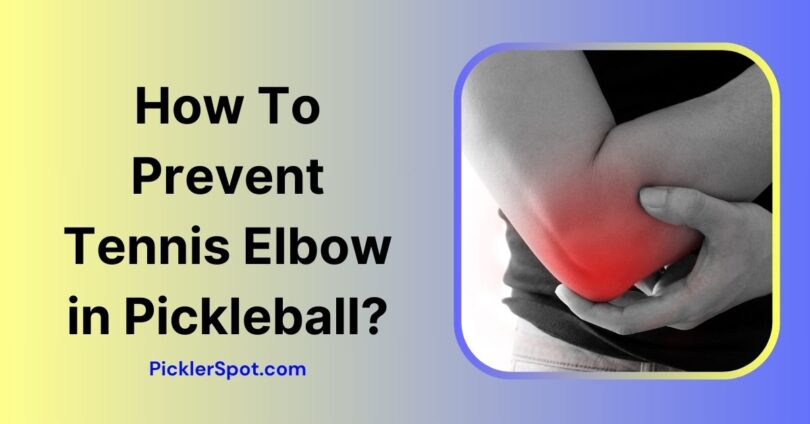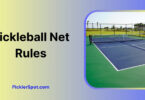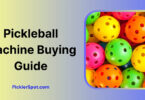Injuries during sports are a massive yet inevitable bane in an athlete’s life, not only is it a rough experience to go through but it also becomes a hurdle whenever you are climbing the stepping stones of your career.
In Pickleball, joint and muscle-related injuries aren’t a rare phenomenon, in fact, fiascos such as tennis elbow are something you would often witness the most and God forbid that you encounter a first-hand experience with it since it’s indeed a rough patch to follow through.
Luckily for you, as scary as it may sound, there are actually ways to prevent tennis elbow in pickleball, which I will be demonstrating in this article down below.
What Exactly Is Tennis Elbow & What Are Its Symptoms?
Tennis elbow which is otherwise known as Lateral epicondylitis in the field of medicine is a nasty little foe that lurks and plagues almost every athlete every now and then especially their elbow region which often takes tenfolds of beating regardless of your playstyle since it corresponds to your wrist moving away from your palm repeatedly causing a wear and tear effect which then creates micro-tears that are exacerbated if not treated properly.
These muscles are often located at the forearm region, however, the spike of damage is often felt right across the elbow especially when a heavy weight is lifted or if a person stretches their arm too much.
Since pickleball requires an individual to use their arms for most of the duration of the session, playing when you have a sore arm due to Lateral epicondylitis can undoubtedly cause you immense pain and even aggravate your injury.
In the early stages, Lateral epicondylitis or Tennis elbow is often felt as tingling and minor soreness, however, once the injury reaches moderate stages, the pain is often like dullness that stings all the way to the forearm. Some of its most common symptoms are,
- Stiffness that restricts arm movement
- Swelling across the elbow region
- Radiating pain that is tender to touch
- Loss of strength when clutching
How To Prevent Tennis Elbow in Pickleball?
If you were already feeling some of these symptoms may pop up eventually or simply do not want to deal with them since not only is it a painful experience but may also ruin your form in the long run, here is how you could possibly prevent it.
Avoid Pushing Your Limits
Remember you tried to emulate your favorite professional you were watching earlier on YouTube? Well, it is about time you ditch those since you are pretty much putting yourself at pushing your limits. It’s never implied that you shouldn’t follow your ideals or try to replicate their gaming techniques but on the other hand, these professionals tend to pour their heart into every move by investing sweat and blood.
In that case, they often have the stamina and the muscles already being built up from years of training education, and professional-level coaching.
Always stay in your lane and take one step at a time when learning a new move, don’t try to execute every method you learn on the whim and perform it, as theory is undoubtedly different than practical since in theory, you don’t really have to put your body on the line.
Stick With Your Own Moveset
The core of the body along with your shoulder is your powerhouse, never try to swing the paddle as if you are swatting a fly, this way you can eliminate the wear and tear effect on your shoulder and elbow, try following a body fluid motion that will create enough force for you to execute power whenever needed to execute a robust shot and you won’t be sacrificing your flexibility whenever playing aggressively.
Ensure your wrist is as flexible and relaxed as possible, stretching and stiffening it unnecessarily is going to damage your forearm muscle since the tension created can create minor tears in your hand.
Learn to Grip Properly
I have seen so many players make this mistake, clutching on a paddle as if their life depended on it, in pickleball, you are supposed to have fun acting as a potential threat to your own wrists.
Avoid death grips and learn to swing with either continental or western grip, in this way, your shoulder and your forearm will easily accommodate your movement regardless of the fact you are flanking or covering the mid-region with your sensitive Dinks.
Warm Up Is Necessary
Once you have stepped into the court, don’t just start right away, give your body the stretching it needs to warm up, in that way, your muscles can become tender with plenty of blood flowing through them.
Try doing jumping jacks as well as push-ups a couple of times in order to keep your blood circulation pumped up otherwise without a proper warmup your hands will feel stiff and suffer from massive wear and tear.
Icing is The Key
If you know a thing or two about the professional athlete you must also be aware of pheneoma which is known as “recovery”. It is the phase when they take their time to ice their potential wounds and muscle tenderness to prevent them from exacerbating.
This also jumpstarts the natural healing process as icing sore body parts can work wonders, think of it like giving your arm a special spa or massaging routine.
Find The Correct Equipment
This may sound trivial but most of the arm fatigue is often caused by choosing the wrong type of Paddles. Just because your friend or partner is swinging a bulkier paddle doesn’t mean you should. Finding the right type of paddle is like finding your perfect soul mate, except this time it is in the court.
On the other hand, using all your energy by giving your forearm the beating whilst carrying a heavier paddle that is definitely out of your league can cause unnecessary fatigue and is the perfect recipe for disaster.
Make sure you opt for a lightweight build and try to train your arm so that it becomes adept to all the extra efforts you are putting into the court, use lead tapes if necessary to calibrate the paddle according to your moves.
Bottom Line
Getting your tendons torn or stretched is a thought that will certainly send chills up anyone’s spine. Although there are ways to treat Lateral epicondylitis otherwise known as tennis elbow it’s best that you take precautionary measures beforehand.
Make sure you follow my tips mentioned above on How to prevent tennis elbow in pickleball, feel free to comment below if you have any other questions in mind.









